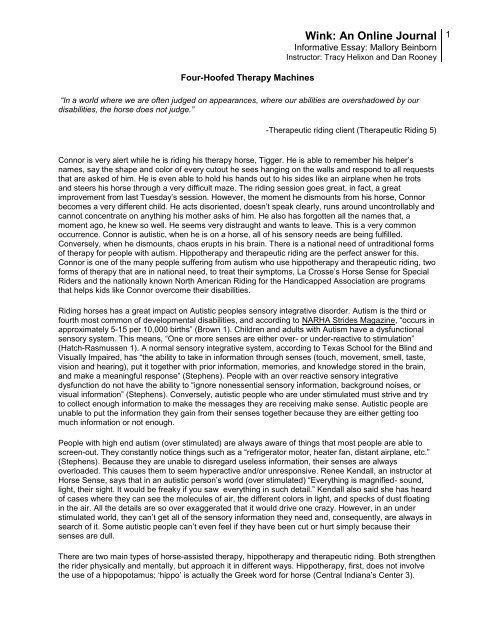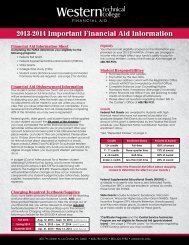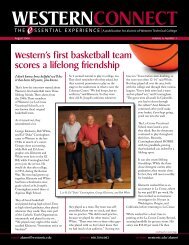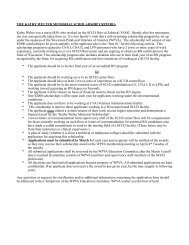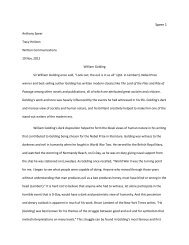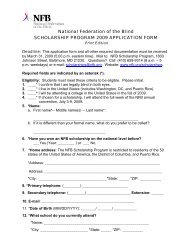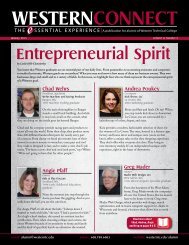Four-Hoofed Therapy Machines - Western Technical College
Four-Hoofed Therapy Machines - Western Technical College
Four-Hoofed Therapy Machines - Western Technical College
Create successful ePaper yourself
Turn your PDF publications into a flip-book with our unique Google optimized e-Paper software.
Wink: An Online JournalInformative Essay: Mallory BeinbornInstructor: Tracy Helixon and Dan Rooney3There are many games and exercises that are done at HSSR to promote healing therapeuticexperiences. The riders play many games including, relay races, “Simon Says,” “Red Light Green Light,”and matching games. They also frequently get to go on trail rides and perform tricks while on their horses,such as “Around the World” and sitting backwards (Joswick 159). The activities they can do while onhorses are endless. “Through games and exercises, it is possible to work on a variety of academic skillareas (sequential memory, closure, counting, shapes, etc), as well as body image and self confidencebuilding activities” (Joswick 159). Renee Kendall, an instructor at Horse Sense, says, “Each day isplanned with each rider‟s specific needs and goals in mind” (Kendall). All of the activities are chosen tohelp the riders physically, mentally, emotionally and any other way possible. Through my own personalexperiences at Horse Sense, I have noticed that riding horses gives the disabled a feeling of pride, selfesteem,and self worth. There is no better thrill than sitting on an animal that towers above you, and thencontrolling it all by yourself! When riders leave HSSR, there is always a smile on each face! Throughoutthe past sixteen years, HSSR has helped many „special riders‟ strengthen themselves mentally andphysically and have fun while doing it.Paula Hueners and Cheryl Cade founded Horse Sense for Special Riders in 1987. Kendall said thatHueners was already working in the school system with disabled children, and, in addition, had a greatdeal of horse experience when she realized that something was missing from the traditional therapyprogram and “identified the need for” Horse-Assisted <strong>Therapy</strong> (Kendall).Horse Sense for Special Riders is funded through Rider Tuitions, the generosity of donors and, mostly, itis made possible through the “support of our community” (Kendall), and two annual fundraisers (TheChair Affair and Ride-a-Thon). Courtney Beinborn, a fifth grader at Southern Bluffs Elementary Schoolwas so touched by what this program has done for her sister, that she has started up a collection called“Cents for Horse Sense” at her school. So far, she has raised over $200.00! Courtney said that shewanted to help Horse Sense out “partly because I saw their wish list” (they were in need of money to buyitems that their allowance didn‟t cover) “and because it‟s helped Megan so much.” Her sister, Megan, isan autistic rider at Horse Sense, and over the past years has accomplished some amazing feats thanksto her favorite form of therapy, Therapeutic Riding (Beinborn).North American Riding for the Handicapped Association (NARHA), founded in 1969, promotes horseassistedtherapy in the United States and Canada. There are more than 650 NARHA program centers,“with dozens of new centers initiating new programs and thousands of individuals profiting from thesebeneficial activities” that serve around 30,000 disabled people (About NARHA). They are also beginningto support and represent recreational riding for people with disabilities such as “equine-assistedpsychotherapy, driving, vaulting, competition, and other therapeutic and educational interactions withhorses” (About NARHA). Many disabilities are helped through this, but I think that one of the mostimportant is autism. NARHA is doing a wonderful job meeting the national need of using different forms oftherapy for autism. Judging by the enthusiasm and rapid growth of these programs, I think this will be aprogram that sticks around for a long time.Autism is a very devastating disorder. The people are trapped in a world that more than likely scaresthem most of the time. Luckily, new Hippotherapy and Therapeutic Riding programs are popping uparound the world because more people are starting to realize the national need for these programs. Eachtime a autistic child is able to be part of, and work well at a riding session, he or she is released from thepressures of their everyday life. Instructors and therapists hope they can somehow realize that they cansomewhat control what is happening to them and learn how to screen out useless sensory information. Ifthat isn‟t able to happen, at least they will be able to have an hour off each week from their over or understimulated lives.


